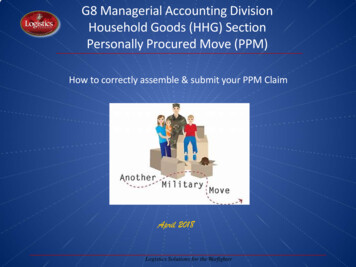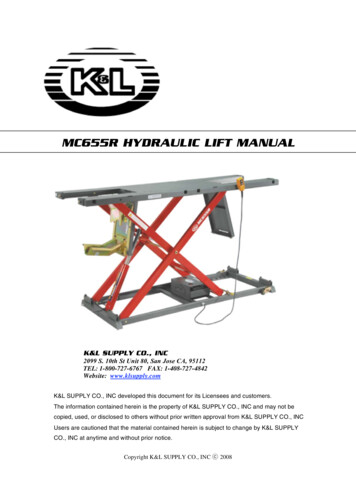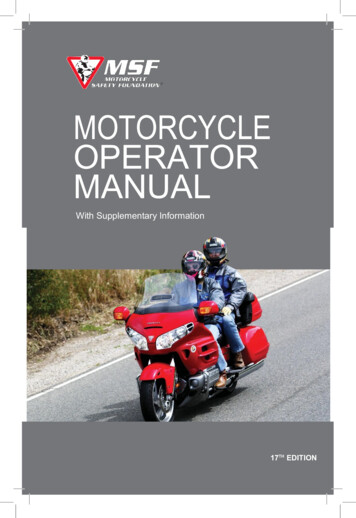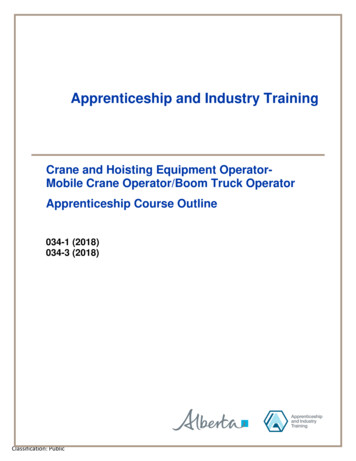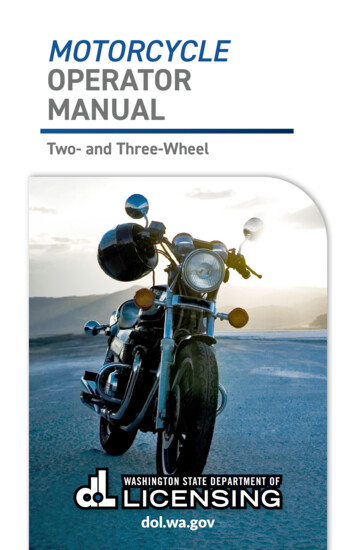
Transcription
MOTORCYCLEOPERATORMANUALTwo- and Three-Wheeldol.wa.gov
EFILrofGNINITRAom Your RideGet More FrTo find out why, check out our videos .htmldol.wa.gov520-407 (R/12/19)
CONTENTSWASHINGTON MOTORCYCLE SAFETY PROGRAMTwo- and Three-Wheel Motorcycle Endorsements. . . . . . . . . . . . . 1-1Obtaining Your Permit/Endorsement . . . . . . . . . . . . . . . . . . . . . . . . . 1-2Endorsement Fees. . . . . . . . . . . . . . . . . . . . . . . . . . . . . . . . . . . . . 1-2Instruction Permits. . . . . . . . . . . . . . . . . . . . . . . . . . . . . . . . . . . . . . 1-3Rider Training and Education . . . . . . . . . . . . . . . . . . . . . . . . . . . . . . .Two-Wheel Rider Education Courses . . . . . . . . . . . . . . . . . . . . . . .Novice Rider Courses . . . . . . . . . . . . . . . . . . . . . . . . . . . . . . . . . . .Intermediate Rider Courses. . . . . . . . . . . . . . . . . . . . . . . . . . . . . . .Advanced Rider Courses. . . . . . . . . . . . . . . . . . . . . . . . . . . . . . . . .1-31-41-41-41-4Three-Wheel Rider Education Courses. . . . . . . . . . . . . . . . . . . . . . . . 1-5Novice Three-Wheel Rider Course . . . . . . . . . . . . . . . . . . . . . . . . . 1-5Advanced Three-Wheel Rider Courses. . . . . . . . . . . . . . . . . . . . . . 1-5Endorsement Testing. . . . . . . . . . . . . . . . . . . . . . . . . . . . . . . . . . . . . . 1-6Transferring from Out-of-State . . . . . . . . . . . . . . . . . . . . . . . . . . . . . . 1-6PREPARING TO RIDECreate Your Own Safety . . . . . . . . . . . . . . . . . . . . . . . . . . . . . . . . . . . 2-1Create Your Own Safety with Functional Gear. . . . . . . . . . . . . . . . . .Helmets . . . . . . . . . . . . . . . . . . . . . . . . . . . . . . . . . . . . . . . . . . . . . .Helmet Types and Construction. . . . . . . . . . . . . . . . . . . . . . . . . . . .Helmet Fit. . . . . . . . . . . . . . . . . . . . . . . . . . . . . . . . . . . . . . . . . . . . .2-22-22-22-4Eye Protection. . . . . . . . . . . . . . . . . . . . . . . . . . . . . . . . . . . . . . . . . . . . 2-4Protective Gear. . . . . . . . . . . . . . . . . . . . . . . . . . . . . . . . . . . . . . . . . . .Jacket and Pants. . . . . . . . . . . . . . . . . . . . . . . . . . . . . . . . . . . . . . .Boots and Shoes. . . . . . . . . . . . . . . . . . . . . . . . . . . . . . . . . . . . . . .Gloves . . . . . . . . . . . . . . . . . . . . . . . . . . . . . . . . . . . . . . . . . . . . . . .Hearing Protection. . . . . . . . . . . . . . . . . . . . . . . . . . . . . . . . . . . . . .Comfort and Weather Protection. . . . . . . . . . . . . . . . . . . . . . . . . . .Visibility . . . . . . . . . . . . . . . . . . . . . . . . . . . . . . . . . . . . . . . . . . . . . .Understanding and Inspecting Your Motorcycle. . . . . . . . . . . . . . .2-52-52-62-62-62-62-72-7Choosing the Right Motorcycle. . . . . . . . . . . . . . . . . . . . . . . . . . . . . . 2-7Getting to Know Your Motorcycle. . . . . . . . . . . . . . . . . . . . . . . . . . . 2-8Checking Your Motorcycle. . . . . . . . . . . . . . . . . . . . . . . . . . . . . . . . 2-8Create Your Own Safety by Taking Responsibility . . . . . . . . . . . . 2-10i
RIDING A TWO-WHEELED MOTORCYCLEThe Right Bike for You. . . . . . . . . . . . . . . . . . . . . . . . . . . . . . . . . . . . . 3-1Differences between Two- and Three-Wheeled Motorcycles. . . . . . 3-1Riding Posture. . . . . . . . . . . . . . . . . . . . . . . . . . . . . . . . . . . . . . . . . . . .Basic Controls and Operation . . . . . . . . . . . . . . . . . . . . . . . . . . . . .Clutch Control and Shifting Gears. . . . . . . . . . . . . . . . . . . . . . . . . .Two-Wheel Steering. . . . . . . . . . . . . . . . . . . . . . . . . . . . . . . . . . . .Cornering. . . . . . . . . . . . . . . . . . . . . . . . . . . . . . . . . . . . . . . . . . . . .Cornering Steps. . . . . . . . . . . . . . . . . . . . . . . . . . . . . . . . . . . . . . . .Cornering Lines. . . . . . . . . . . . . . . . . . . . . . . . . . . . . . . . . . . . . . . .Look, Anticipate, Choose. . . . . . . . . . . . . . . . . . . . . . . . . . . . . . . . .3-13-23-33-33-33-43-53-7Braking. . . . . . . . . . . . . . . . . . . . . . . . . . . . . . . . . . . . . . . . . . . . . . . . . . 3-8Braking in a Straight Line. . . . . . . . . . . . . . . . . . . . . . . . . . . . . . . . . 3-8Braking in a Corner . . . . . . . . . . . . . . . . . . . . . . . . . . . . . . . . . . . . . 3-8Evasive Maneuvers. . . . . . . . . . . . . . . . . . . . . . . . . . . . . . . . . . . . . 3-9Quick Stops. . . . . . . . . . . . . . . . . . . . . . . . . . . . . . . . . . . . . . . . . . . 3-9Swerves. . . . . . . . . . . . . . . . . . . . . . . . . . . . . . . . . . . . . . . . . . . . . 3-10Carrying Passengers and Cargo. . . . . . . . . . . . . . . . . . . . . . . . . . . . 3-10RIDING A THREE-WHEELED MOTORCYCLETypes of Three-Wheelers: The Right Trike for You . . . . . . . . . . . . . .Differences between Two- and Three-Wheeled Motorcycles. . . . .Advantages . . . . . . . . . . . . . . . . . . . . . . . . . . . . . . . . . . . . . . . . . . .Disadvantages. . . . . . . . . . . . . . . . . . . . . . . . . . . . . . . . . . . . . . . . .4-14-14-24-2Riding Posture . . . . . . . . . . . . . . . . . . . . . . . . . . . . . . . . . . . . . . . . . . . 4-2Basic Controls and Operation . . . . . . . . . . . . . . . . . . . . . . . . . . . . . 4-3Clutch Control and Shifting Gears. . . . . . . . . . . . . . . . . . . . . . . . . . 4-3Unique Handling Characteristics. . . . . . . . . . . . . . . . . . . . . . . . . . . .Three-Wheel Steering. . . . . . . . . . . . . . . . . . . . . . . . . . . . . . . . . . .Tip-Over Lines. . . . . . . . . . . . . . . . . . . . . . . . . . . . . . . . . . . . . . . . .“Flying” and Steering Reversion . . . . . . . . . . . . . . . . . . . . . . . . . . .Yaw . . . . . . . . . . . . . . . . . . . . . . . . . . . . . . . . . . . . . . . . . . . . . . . . .Cornering. . . . . . . . . . . . . . . . . . . . . . . . . . . . . . . . . . . . . . . . . . . . .Cornering Steps. . . . . . . . . . . . . . . . . . . . . . . . . . . . . . . . . . . . . . . .When Turning a Trike. . . . . . . . . . . . . . . . . . . . . . . . . . . . . . . . . . . .When Turning a Sidecar Rig . . . . . . . . . . . . . . . . . . . . . . . . . . . . . .Hills . . . . . . . . . . . . . . . . . . . . . . . . . . . . . . . . . . . . . . . . . . . . . . . . .ii4-44-44-44-64-64-74-84-94-94-9
Drifting. . . . . . . . . . . . . . . . . . . . . . . . . . . . . . . . . . . . . . . . . . . . . . 4-10Braking. . . . . . . . . . . . . . . . . . . . . . . . . . . . . . . . . . . . . . . . . . . . . . . . . 4-10Braking in a Straight Line. . . . . . . . . . . . . . . . . . . . . . . . . . . . . . . . 4-10Braking in a Corner . . . . . . . . . . . . . . . . . . . . . . . . . . . . . . . . . . . . 4-10Evasive Maneuvers. . . . . . . . . . . . . . . . . . . . . . . . . . . . . . . . . . . . . . .Quick Stops. . . . . . . . . . . . . . . . . . . . . . . . . . . . . . . . . . . . . . . . . .Swerves. . . . . . . . . . . . . . . . . . . . . . . . . . . . . . . . . . . . . . . . . . . . .Carrying Passengers and Cargo. . . . . . . . . . . . . . . . . . . . . . . . . .4-114-114-124-12STRATEGIES FOR THE STREETStreet Strategies. . . . . . . . . . . . . . . . . . . . . . . . . . . . . . . . . . . . . . . . . .Seeing and Being Seen. . . . . . . . . . . . . . . . . . . . . . . . . . . . . . . . . .Lane Choice. . . . . . . . . . . . . . . . . . . . . . . . . . . . . . . . . . . . . . . . . . .Lane Position. . . . . . . . . . . . . . . . . . . . . . . . . . . . . . . . . . . . . . . . . .5-15-15-15-3Being Visible. . . . . . . . . . . . . . . . . . . . . . . . . . . . . . . . . . . . . . . . . . . . . 5-4Creating Time and Space. . . . . . . . . . . . . . . . . . . . . . . . . . . . . . . . . . .Total Stopping Distance. . . . . . . . . . . . . . . . . . . . . . . . . . . . . . . . . .Look Farther Down the Road. . . . . . . . . . . . . . . . . . . . . . . . . . . . . .Following Distance. . . . . . . . . . . . . . . . . . . . . . . . . . . . . . . . . . . . . .Being Followed . . . . . . . . . . . . . . . . . . . . . . . . . . . . . . . . . . . . . . . .Proactive Strategy. . . . . . . . . . . . . . . . . . . . . . . . . . . . . . . . . . . . . .5-55-55-65-65-65-7Roadway Management Skills. . . . . . . . . . . . . . . . . . . . . . . . . . . . . . . . 5-7Intersections. . . . . . . . . . . . . . . . . . . . . . . . . . . . . . . . . . . . . . . . . . 5-7Surface Hazards . . . . . . . . . . . . . . . . . . . . . . . . . . . . . . . . . . . . . . . 5-8Crossing an Obstacle. . . . . . . . . . . . . . . . . . . . . . . . . . . . . . . . . . 5-10Changing Lanes. . . . . . . . . . . . . . . . . . . . . . . . . . . . . . . . . . . . . . . 5-10Passing . . . . . . . . . . . . . . . . . . . . . . . . . . . . . . . . . . . . . . . . . . . . . 5-10Riding at Night. . . . . . . . . . . . . . . . . . . . . . . . . . . . . . . . . . . . . . . . 5-11Target Fixation. . . . . . . . . . . . . . . . . . . . . . . . . . . . . . . . . . . . . . . . 5-12Group Riding. . . . . . . . . . . . . . . . . . . . . . . . . . . . . . . . . . . . . . . . . . . .Give Each Other Space. . . . . . . . . . . . . . . . . . . . . . . . . . . . . . . . .Staggered Formation . . . . . . . . . . . . . . . . . . . . . . . . . . . . . . . . . .Ride Your Own Ride. . . . . . . . . . . . . . . . . . . . . . . . . . . . . . . . . . .5-125-135-135-13IMPAIRMENTSTypes of Impairments. . . . . . . . . . . . . . . . . . . . . . . . . . . . . . . . . . . . . . 6-1Alcohol and Drugs. . . . . . . . . . . . . . . . . . . . . . . . . . . . . . . . . . . . . . 6-1Marijuana . . . . . . . . . . . . . . . . . . . . . . . . . . . . . . . . . . . . . . . . . . . . 6-3iii
Alcohol and the Law. . . . . . . . . . . . . . . . . . . . . . . . . . . . . . . . . . . .Consequences of Conviction. . . . . . . . . . . . . . . . . . . . . . . . . . . . . .Technology. . . . . . . . . . . . . . . . . . . . . . . . . . . . . . . . . . . . . . . . . . . .Body and Emotions. . . . . . . . . . . . . . . . . . . . . . . . . . . . . . . . . . . . .Peer Pressure . . . . . . . . . . . . . . . . . . . . . . . . . . . . . . . . . . . . . . . . .Riding in Groups . . . . . . . . . . . . . . . . . . . . . . . . . . . . . . . . . . . . . . .6-36-36-46-46-56-6Own Your Ride. . . . . . . . . . . . . . . . . . . . . . . . . . . . . . . . . . . . . . . . . . . .Never Stop Training. . . . . . . . . . . . . . . . . . . . . . . . . . . . . . . . . . . . .Wear the Gear. . . . . . . . . . . . . . . . . . . . . . . . . . . . . . . . . . . . . . . . .Challenge Peer Pressure. . . . . . . . . . . . . . . . . . . . . . . . . . . . . . . . .Ride Sober and Undistracted. . . . . . . . . . . . . . . . . . . . . . . . . . . . . .Create your own Safety. . . . . . . . . . . . . . . . . . . . . . . . . . . . . . . . . .Always Ride Within your Skill Level . . . . . . . . . . . . . . . . . . . . . . . .6-66-66-66-76-76-76-8Notes . . . . . . . . . . . . . . . . . . . . . . . . . . . . . . . . . . . . . . . . . . . . . . . . . . . 7-1iv
This guide should not be used as a basis for legal claims or actions.Traffic regulations in cities, towns, and counties may go beyondstate laws but cannot conflict with them . If you are interestedin specific laws relating to motor vehicle operation, motorcycleoperations, and driver licensing, refer to Title 46 RCW, MotorVehicles. Please read it carefully .We welcome your written comments or suggestions. Yourcomments should be addressed to:Motorcycle Safety ProgramDepartment of LicensingPO Box 9030Olympia, WA 98507You can always find the most recent version of this guide as well asother current information on our website at www.dol.wa.gov.This motorcycle operator’s manual includes information provided byNational Public Services Research Institute (NPSRI), the NationalHighway Traffic Safety Administration (NHTSA), the MotorcycleSafety Foundation (MSF), Evergreen Safety Council (ESC), and theAmerican Association of Vehicle Administrators (AAMVA) .Published by the Washington State Department of Licensing .We are committed to providing equal access to our services.For more information visit dol.wa.gov/access (TDD/TTY 711).v
WASHINGTON MOTORCYCLESAFETY PROGRAMThis manual is provided by the Washington State Departmentof Licensing (DOL) and Washington Motorcycle Safety Program(WMSP); it provides motorcycle riding techniques and informationfor both inexperienced and experienced riders.Our goal is to foster and promote safe motorcycle riding through: Quality rider training programs Public information campaigns throughout Washington State Permit and endorsement issuance through comprehensiveevaluations.Rider education training courses in Washington are recognizednationally. Training is conducted locally by DOL-approved providers,and subsidized through the use of motorcycle endorsement andrenewal fees.For more information on endorsement and permit fees, motorcyclelaws, or to find a motorcycle training/testing provider closest to you,visit: dol.wa.gov.Two- and Three-Wheel Motorcycle EndorsementsYou must have a motorcycle permit or endorsement on your driverlicense to legally operate a motorcycle on Washington Stateroadways. State law mandates separate training, testing, andendorsements for two- and three-wheeled motorcycles because ofthe differences in handling.To lawfully operate: A two-wheeled motorcycle, you must have a two-wheel(“Class 3” endorsement if license issued prior to June 2017) or(Endorsement L with restriction [J — two-wheeled motorcycleonly] for license issued after June 2017). A three-wheeled motorcycle (sidecar rig, trike, reverse trike, etc.)you must have a three-wheel (“Class 5” endorsement for licenseissued prior to June 2017) or (Endorsement L with restriction[J — three-wheeled motorcycle only] for license issued afterJune 2017).1-1
Both two-wheeled and three-wheeled motorcycles, youmust have a combined two-wheel and three-wheel (“Class7” endorsement for license issued prior to June 2017) or(Endorsement L with restriction [J — two-wheeled & threewheeled motorcycle] for license issued after June 2017).Your motorcycle may be impounded if it is operated on publicroadways without the required endorsement. The current minimumfine for riding without an endorsement is 386.Liability insurance is mandatory for all motorcycles under RCW46.30.020Obtaining Your Permit/EndorsementYou must pass both a basic knowledge and skills test to obtain apermit. You are required to take an advanced knowledge and skillsexam to get an endorsement.You can find training/testing providers at: dol.wa.gov/driverslicense/motoschools.html.Similar to other sports, motorcycling requires specialized physicaland mental skill; training and practice are required to develop andmaintain these skills. The consequences of not being proficientin this sport are serious injury or even death. Taking additionaladvanced training to improve your physical and mental riding skillswill help you become a safer rider.Washington State Law requires all riders under 18 years of age tosatisfactorily complete an approved rider course before applying foran endorsement. Students under the age of 18 must have parentalpermission to take a training course and apply for an endorsement.Endorsement FeesYou can find current motorcycle endorsement fees at: dol.wa.gov/driverslicense/fees.htmlMotorcycle endorsement and renewal fees are used to subsidizemotorcycle safety training classes, to promote motorcycle safetyand awareness throughout Washington State, and for programadministration.1-2
Instruction PermitsYou must pass a basic knowledge and skills test in order to applyfor a 180-day permit to drive on public roadways. Riders must beat least 16 years of age, and possess a current Washington driverlicense.Riders with instruction permits are restricted from carryingpassengers or riding at night.Permits expire after 180 days, and may be renewed one time withina 5-year period.Knowledge tests are conducted by contracted training/testingproviders.Find training/testing providers near you at: dol.wa.gov/driverslicense/mototraining.htmlRider Training and EducationThe Washington Motorcycle Safety Program highly encouragesyou to take both initial and on-going motorcycle training. Riderswho do not take official training courses miss out on key teachingssuch as technique, street strategies, and skill development fromprofessional motorcycle instructors.The Department of Licensing has approved a variety of novice,intermediate, and advanced two- and three-wheel training coursesthat are available throughout Washington State. Completion ofa motorcycle training course may qualify you for a discount onmotorcycle insurance. Make sure you become the best in your sportby learning the essentials, but also pick up tips and tricks from theprofessionals!There is a waiting period of three business days after you havecompleted a training course before you may visit a licensing officeto have your permit or endorsement added.1-3
Two-Wheel Rider Education CoursesNovice Rider CoursesA course for new riders with little or no experience, which normallylasts for two or more days.Novice rider training offers: Classroom instruction and approved curriculum materialscovering topics such as basic motorcycle operation, ridingtechniques, street strategies, and protective gear Use of a training motorcycle for the class, or you may use yourown* Hands-on riding instruction in a protected training area Knowledge and skills permit tests as a part of the course* Your motorcycle must pass a pre-ride inspection, and you must provide proof ofinsurance when using your personal motorcycle.Intermediate Rider CoursesThis course is designed for returning riders, or riders with basicmotorcycle knowledge. Intermediate training is usually a one-daycourse, and offers: Tailored classroom instruction and approved curriculum materialscovering topics such as riding techniques, street strategies, andprotective gear Use of a motorcycle for the class, or you may use your own* Hands-on riding instruction in a protected training area Knowledge and skills permit tests as a part of the course* Your motorcycle must pass a pre-ride inspection, and you must provide proof ofinsurance when using your personal motorcycle.Advanced Rider CoursesAdvanced rider courses are designed for experienced riders andwill give you an opportunity to increase your skills on your ownmotorcycle.*1-4
These courses may offer: Riding practice that includes advanced braking, cornering, andswerving Discussion of advanced techniques and defensive streetstrategies Students provide their own motorcycles for this course. Endorsement test may be taken with this course*You must show proof of insurance, and your motorcycle must pass a pre-rideinspection.Three-Wheel Rider Education CoursesNovice Three-Wheel Rider CourseBasic three-wheel courses are designed for riders with little or noexperience on three-wheelers. The course offers: Classroom instruction and approved curriculum materialscovering topics such as basic three-wheel operation, ridingtechniques, street strategies, and protective gear Some locations provide the use of a three-wheeler, or studentsmay use their own three-wheeler* Hands-on riding instruction in a protected training area Knowledge and skills endorsement test as a part of the course.* Your motorcycle must pass a pre-ride inspection, and you must provide proof ofinsurance when using your personal motorcycle.Advanced Three-Wheel Rider CoursesThis course is designed for those with basic and intermediate threewheel riding experience and may offer: Advanced classroom instruction and approved curriculummaterials covering topics such as riding techniques, streetstrategies, and protective gear Hands-on riding instruction in a protected area1-5
Knowledge and skills endorsement test as a part of the course Students provide their own three-wheelers for this course. Youmust show proof of insurance, and your rig must pass a pre-rideinspection.Endorsement TestingBoth two- and three-wheel motorcycle knowledge and skills testsare given by DOL-contracted training schools throughout the state.You do not have to take training in order to take the permit orendorsement tests.There will be a waiting period of three business days after you havecompleted the required exams before you may visit a licensingoffice to have your endorsement added.Please visit our website for more details and DOL-approvedtraining school/testing tmlTransferring from Out-of-StateWhen transferring your out-of-state driver license with a current andvalid motorcycle endorsement to Washington, you must let DOLstaff know that you also want to transfer the endorsement.If you want a two-wheel endorsement when transferring from out ofstate, you must present: A current and valid two-wheel motorcycle endorsementIf you want a three-wheel endorsement when transferring from outof state, you must present: A current and valid three-wheel motorcycle endorsement** Documentation provided must show that you passed a separate and distinctthree-wheel test in the state from which you are transferring. If there is no proofof a separate and distinct three-wheel test, you will only be offered a two-wheelendorsement.Please visit our website for more details and DOL driver licensingservice office locations: https://fortress.wa.gov/dol/dolprod/dsdoffices/1-6
PREPARING TO RIDECreate Your Own SafetyLike the choice to drive, the choice to ride carries with it a certainamount of risk. However, motorcycle riders face risk in different andmore significant ways: traction, weather, and potential road hazardsall pose considerable challenges to riders that drivers don’t oftenface.Adding to these increased risks are factors related to: Protection – lack of protection that is built into vehicles: no seatbelts, air bags, or steel roll cages Stability – difference in stability and balance (four wheels vs.three or only two) Traction – two wheels are much more affected by surfacehazards than four Comfort – riders are more exposed to elements than drivers are Visibility – motorcycles are much harder to see than cars.The majority of motorcycle crashes involve several risk factorsstacking up at one time. As an example, think of a tower of blocksbeing stacked on end. Each block represents a different risk that arider must be aware of and learn to manage. If the tower is stackedtoo high, it falls. The same can be true when riding—too many risksstacked up eventually cause a fall. The constant development andpractice of physical and mental riding skills can help you reduce oreliminate many risks when riding.Does choosing to ride a motorcycle increase your risk comparedto driving a car? Yes. Riding is different from driving in that youmust think like a rider instead of like a driver. You must increaseawareness of your environment and how your vehicle handles, allwhile responding proactively to hazards.Are there ways that you can actively manage these risks? You canmanage some of these risks by preparing for every single ride. Isyour body protected? Is your bike ready? Are YOU ready?Remember that your own skill and behavior is the greatest risk toyou as a motorcyclist. Recognize, accept, and manage your risks.2-1
Create Your Own Safety with Functional GearOne way to manage risk is to choose gear that offers: Protection – from both abrasion and impact Comfort – to keep you focused on the road Visibility – to help other road users see youProtective gear can significantly reduce risk by providing protectionin a crash, comfort in varying weather conditions, and visibility soothers on the road can see you.HelmetsThe most common cause of rider death in motorcycle crashesis head injury. Regardless of speed, helmeted riders are muchmore likely to survive a head injury in a crash than those riders notwearing a helmet. The single most important thing you can do toreduce risk and improve your chances of surviving a crash is towear a quality, properly fitted, and securely fastened helmet.To legally ride in Washington you are required to wear a helmet thatis compliant with Department of Transportation (DOT) guidelines.DOT compliance is indicated by “DOT” labels on the rear exterior,as well as interior of the helmet.Novelty helmets are not DOT compliant, and may not be worn onpublic roadways when riding a two- or three-wheeled motorcycle.Helmet Types and ConstructionHelmets come in a variety of styles (Figure 2-1), including full-face(A), modular or flip-up (B), three-quarter shell (C), and half shell (D).Half-shell and three-quarter shell helmets do not provide protectionfor your chin and face in a crash. Full-face helmets are consideredthe safest helmet, as they provide the best protection for theseareas.Regardless of style, DOT-compliant helmets are required to have: An impact-resistant outer shell An impact-absorbing inner liner (usually of ExpandedPolystyrene [EPS] foam)2-2
ABCDFigure 2-1Types of helmets A comfort liner (the padding) A neck- or chin-strap type of retention systemA helmet should be replaced if it has obvious defects such ascracks or frayed straps, and after being involved in a crash. Manymanufacturers recommend you replace a helmet every five yearsdue to the breakdown of protective materials over time.In addition to DOT compliance, helmets may have other safetycertifications. The most common of these are Snell (from theSnell Memorial Foundation) and ECE (Economic Commissionfor Europe). You should research different helmet styles andcertifications to help determine which helmet is best for you.Remember, all helmets legally allowed in Washington must be atleast DOT compliant.2-3
Another consideration when choosing a helmet is how it canhelp you be more visible to other road users. Being visible is animportant part of reducing risk, so think about switching from adark-colored helmet to a brightly-colored, or white helmet.Helmet FitApart from styles and certifications, one of the most importantfactors of a helmet’s ability to protect you is how it fits. A helmetshould fit snugly all the way around:
must have a combined two-wheel and three-wheel ("Class 7" endorsement for license issued prior to June 2017) or (Endorsement L with restriction [J — two-wheeled & three-wheeled motorcycle] for license issued after June 2017) . Your motorcycle may be impounded if it is operated on public roadways without the required endorsement .
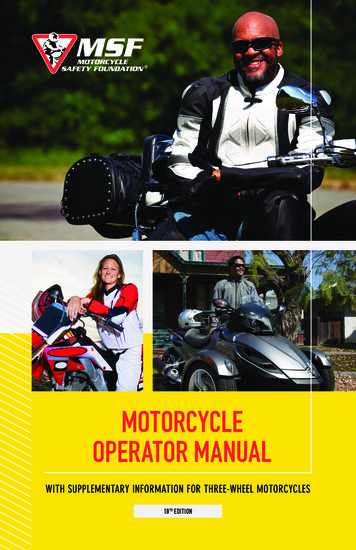
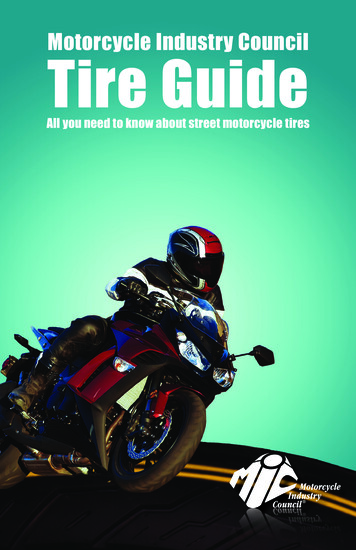
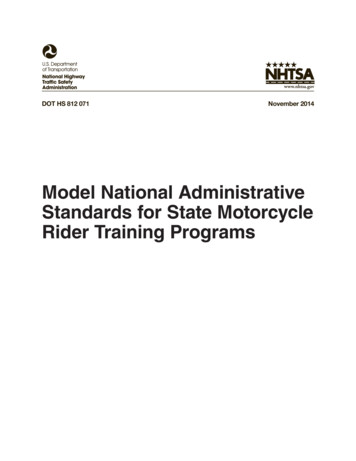
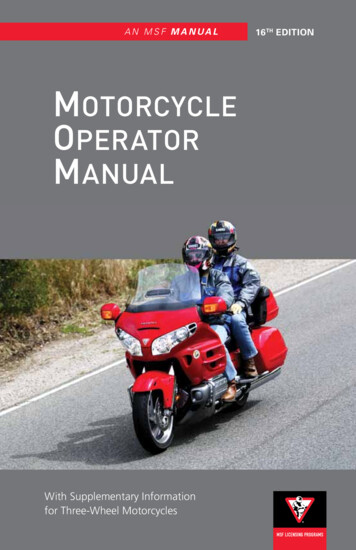

![Motorcycle Mechanic [MM] - CTEVT](/img/5/motorcycle-20-20mechanic-2010.jpg)

